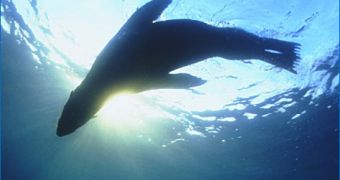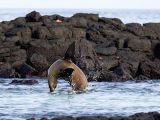1.Eared seals originated from Enaliarctidae, small mammals that inhabited the northern shores of the Pacific 12-13 million years ago. The first known eared seal is Pithanotaria starri, a small seal which lived 11 million years ago. Males were the same size as females.
Eight million years ago, the first proper seals appeared with males larger than females. Five million years ago, they crossed the Pacific to colder waters in the western South America. The separation sea lions (Otariinae)-fur seals (Arctocephalinae) occurred 2-3 million years ago.
Scientists thought the eared seals and walruses had a common origin with bears and dogs, while true seals had a common origin with otters, in the northern Atlantic, 14 million years ago. Still, more recent DNA analyses showed that all seals have a common origin.
Unlike true seals, eared seals did not completely lose their ear pinna.
2.Sea lions can reach in gallop on land 25-30 km (15.5-19 mi) per hour, being much more rapid than a human! Unlike true seals that crawl like caterpillars on the ground, with the rear limbs placed behind their body, eared seals have rear limbs placed forward beneath the body. They can even scratch with them! In slow movement, they displace like ducks, stepping on wrists. But if scared or angry, they step simultaneously with the fore limbs, their gallop resembling the run of a crooked human.
In the water, they can reach 30 km per hour. The rear limbs act like a rudder (true seals use them as propellers), while the fore limbs are used for "flying" underwater just like the penguins. This explains the developed muscles of the fore part of the body that makes them mobile on the land, too. In the fore limbs, the phalanges continue with cartilaginous batons that confer elasticity. The body is hydrodynamic, thinner towards the rear part. The limb bones are located inside the body, leaving outside just the swimming palettes.
Sea lions usually dive for 2 minutes, while the maximum dive is of 12 minutes. They dive down to 70-270 m (230-900 ft). A 85 kg (200 pounds) sea lion makes 200 dives, each of 2 minutes, in which they catch in average about 60 grams of fish. True seals are better divers, and can resist over 20 minutes underwater, due to their oxygen rich hemoglobin.
The smooth body of the eared seals also limits the heat loss. Sea water temperature, even in tropics, is lower than that of the seals' body. The underskin fatty layer also limits heat losses and in fur seals, this is also intensified by the dense, soft and woolly hair, found beneath the long and thick hairs. This fur can protect the fur seals against polar winds of -100 degrees Celsius. The insulating effect of the fur decreases with depth, as increased water pressure compresses the air stored in the soft hair. It's worth noting that Cape Fur Seals hunt till depths of 100 m (330 ft).
Sea lions eat fish, crustaceans and cephalopods (squids and octopuses). In the Southern Hemisphere, sea lions can feed also on sea birds (like penguins). Sea lions also consume fur seals, both in the Northern and Southern Hemisphere. Young males of Steller Sea Lions regularly consume the young of the fur seals in shallow waters. The Antarctic Fur Seal feeds exclusively on krill (small crustaceans).
Sight is mediocre on the ground, but excellent in the water. On weak light on the ground, they detect just large objects or moving very rapidly. In the water, they see well even in dark, and their eyes are extremely sensitive to green light, an advantage under the water. Still, blind eared seals can eat very well, thus they do not rely on sight for catching prey. Their hearing is more kin underwater than on the ground. Their ears are modified so that they are not bothered by the high pressure of the sonic waves propagating underwater and are completed by a mechanism compensating the increased pressure in the case of dives in deep water. Eared seals have a good spacial hearing, easily detecting the source of the sound even in murky, dark waters.
In the search for food, touch helps a lot, as the long vibrisae, similar to those of the cats, detect well vibrations propagated in the water. Each vibrisa hair is connected to a complicated network of nerves that detect the movement of fish and other animals, enabling the seal to catch prey even if seeing or hearing nothing.
Smell is well developed as males recognize females in heat, and the females her offspring based on scent.
The predators of the eared seals are the great sharks and orcas. 20 orcas can kill in just one hour all the young eared seals of a colony.
3.Eared seals breed in colonies. This may due perhaps because there are few sea shores where they can breed without being disturbed.
We call them colonies, but they are in fact just huge harems. In the case of the northern fur seals, the first to invade the beaches in March are the males. Once they reach the sand, they become aggressive with each other, fighting for the best spots. They do not even go fishing into the sea, to keep the best locations. In the fights, larger males are the winners.
For 2-3 months, their life means fight and hunger, in a general uproar, in blizzard and fog conditions. This is what they like, as on sunny days, the weather gets so harsh for them that they temporarily stop the fights. Around the middle of June, the agitation increases, as thousands of females come from their 6,000 km (3,750 mi) journey, from the shores of California to Alaska (those from Siberia come from Japan and Korea).
Now, males stop the fights, as hierarchies have been established, and they try to lure as many females in their harems. Anyway, the best spots attract most females. Once a female has been "fooled" into the territory of a male, he cuts off her retreat passage, grabs her with the jaws from the nape and throws her over the crowd of already conquered females. The best tactics can produce harems of up to 100 females, but they have on average 50 females.
The males must be alert not only to prevent the females' escape, but also to their neighbors who don't miss the opportunity to steal from his females. If the "owner" takes notice of the theft, the poor female can become the object of a rope game (in which she is the rope), in which one males pulls her from the tail and the other from the nape.
Soon after the harems' formation finishes, the females start to give birth and soon after that enter in the fertility period. Sometimes, the sultan cannot accomplish his duty due to the continuous fightings in which he is not always the winner.
The loser males can suffer severe wounds, despite the thick skin of the eared seals, which makes them more vulnerable to the attacks of a great white shark or an orca. Sometimes, they gather in "associations of the frustrated", far away from the main colony.
Mothers too struggle for the best places, far away from the males' turmoil, because in their skirmishes, males do not pay attention to the offspring, which can be accidentally smashed. The best places for the mother are near rocks close to the beach, under which the offspring can easily hide if necessary.
After mating, the male relaxes the loop, and the females can go fishing, leaving the offspring alone. If she gets killed by a predator in the sea, the orphan is doomed, as neighboring females will not feed it, no matter how much milk they have; oppositely, females are aggressive to foreign young, beating and pushing them away. The mothers and the offspring recognize each other by their call.
This scenario is valid also for the relatives of the fur seals, the sea lions. But amongst the true seals, only the elephant seals form such huge harems. What about the other species? They too form harems of 30-50 females, with beach owners, only that their colonies are looser.
Mating takes place in the water or on the ground. Male sea lions have a frontal bump and in eared seals, males can be 5 times larger than females. Breeding takes place in May-September in the case of the Californian sea lion. Gestation takes 11.5 months, and females can delay the implantation of the embryos so that they give birth one year after the mating. Usually, females give birth two days after reaching the colony. For 6 days, they remain with the offspring, then they enter in heat.
In the case of the Californian Sea Lion (Zalophus californianus), births take place in June. The only offspring is about 6 kg (15 pounds) heavy and 75 cm (2.5 ft) long. It is dependent through the food from its mother untill the next birth. Usually, they follow their mother to the breeding colony next year. The female and the young recognize each other through smell and hearing. While true seals have 2 mammary glands, eared seals have 4.
Sea lions reach sexual maturity by the age of 4-5 years. Longevity is 14 years in the wild (and 31 in captivity).
In the case of the Californian Sea Lion, the male is 2-2.5 m (7-8.3 ft) long, weighing 200-300 kg (440-660 pounds), while the female is 1.5-2 m (5-6.6 ft) long weighing 50-100 kg (110-220 pounds). This species inhabits the Pacific coasts of US, California Peninsula, Gulf of California and Galapagos. There are 150,000 individuals in North America and 40,000 in Galapagos.
A large amount of excrements is found in the eared seals colonies, as females do not go to the sea for defecation. This causes a high rate of mortality of the pups, as they ingest parasite eggs.
4.Sea lions have truncated vibrisae compared to fur seals. There are 4 another sea lion species: Steller sea lion (Eumatopias jubatus) is the largest sea lion: males can be 3 m (10 ft) long weighing 1 tonne, while the female is 2.25 m (7.5 ft) long, weighing 300 kg (660 pounds). The newborn is 1 m (3.3 ft) long and weighs 20 kg (44 pounds). It inhabits rocky islands in cold areas of the whole Pacific shore, from Hokkaido (northern Japan) to California, including the Sea of Okhotsk. There are up to 290,000 individuals.
Southern sea lion (Otaria byronia) inhabits the coasts of southern South America, from Peru to Uruguay, including Falkland and Tierra del Fuego. The male is 2.3 m (7.8 ft) long and weighs 300 kg (660 pounds) while the female is 1.8 m (6 ft) long and weighs about 150 kg (330 pounds). The newborn is 85 cm (2.8 ft) long and weighs 18 kg (40 pounds). There are about 275,000 individuals.
Australian sea lion (Neophoca cinerea) inhabits shores and islands in western and southern Australia. The male is up to 2.5 m (8.3 ft) long and weighs 300 kg (660 pounds), while the female is 1.8 m (6 ft) long and weighs 80 kg (180 pounds). There are up to 5,000 individuals.
New Zealand sea lion (Phocarctos hookeri) inhabits islands near the southern island of New Zealand, the main colony being on Auckland Island. The male is up to 2.5 m (8.3 ft) long, the female 2 m (6.6 ft) and the newborn 80 cm (2.6 ft). There are up to 6,000 individuals.
5.Nine species of fur seals are found. Their vibrisae are conic and the fur extremely dense.
Northern fur seal lives from the water of Hokkaido to California, passing through Aleutian Islands and Pribilof Islands. The male is 2.1 m (7 ft) long and weighs up to 270 kg (600 pounds), the female is 1.5 m (5 ft), weighing 50 kg (110 pounds). The newborn is 65 cm (2.2 ft) long and weighs 5 kg (11 pounds). There are 1,250,000 individuals of this species.
Guadalupe Fur Seal (Arctocephalus townsendi) inhabits the islands of Guadalupe (western Mexico). The male is 1.8 m (6 ft) long and weighs 140 kg (300 pounds). About 2,500 individuals exist.
Galapagos Fur Seal (A. galapagoensis) is the smallest eared seal. The male is 1.5 m (5 ft) long. The forehead is flat and the vibrisae very short. 30,000 individuals live in Galapagos.
Juan Fernandez Fur Seal (A. philippi) inhabits the Juan Fernandez archipelago (off Chile, at 33o S). The male is 1.6 m (5.3 ft) long and weighs 160 kg (350 pounds). About 6,300 individuals exist.
South American Fur Seal (A australis) inhabits the southern South American coasts, from Peru to Uruguay, including Falkland. The male is 1.9 m (6.3 ft) long and weighs 100 kg (220 pounds) while the female is 1.4 m (4.6 ft) long and weighs 48 kg (110 pounds). The newborn is up to 5 kg (11 pounds) heavy. There are about 500,000 individuals.
Subantarctic Fur Seal (A. tropicalis) lives in the Southern Ocean, in the islands of Tristan da Cunha, Gough, Marion, Prince Edward, Crozet, Amsterdam, and Saint Paul. The male is 1.8 m (6 ft) long and weighs 140 kg (300 pounds); the female is 1.3 m (4.3 ft) long and weighs 50 kg (110 pounds). There are about 300,000 individuals.
Antarctic Fur Seal (A gazella) is found in the Southern Ocean in the islands of Kerguelen, Shetland, Orkney, Sandwich, South Georgia, Bouvet, McDonald, Heard, Marion. The male is 1.9 m (6.3 ft) long, weighing 140 kg (300 pounds), while the female is 1.3 m (4.3 ft) long, weighing 50 kg (110 pounds). The newborn is 65 cm (2.2 ft) long and weighs 6 kg (15 pounds).
Cape Fur Seal/Australian Fur Seal (A pusillus) has two populations. The male is up to 2.3 m (7.8 ft) long and weighs up to 360 kg (750 pounds) while the female is up to 1.8 m (6 ft) long and weighs 120 kg (260 pounds). The newborn can be 80 cm (2.6 ft) long, weighing 12 kg (26 pounds). The African individuals are slightly larger than the Australian ones. The Cape fur seals (1,200,000 individuals) inhabit the shores of Namibia and South Africa, while the Australian fur seals (25,000 individuals) the shores of Bass Strait, Victoria, New South Wales, and Tasmania.
New Zealand Fur Seal (A forsteri) inhabits coasts and islands in New Zealand, western Australia (Recherche archipelago) and southern Australia (Kangaroo island). Males are up to 2.2 m (7.3 ft) long and weigh up to 360 kg (760 pounds) while the females are up to 1.7 m (5.6 ft) long and 110 kg (250 pounds) in weight. The newborn is 55 cm (2.8 ft) long and weighs 3.5 kg (8 pounds). There are about 55,000 individuals.

 14 DAY TRIAL //
14 DAY TRIAL // 



